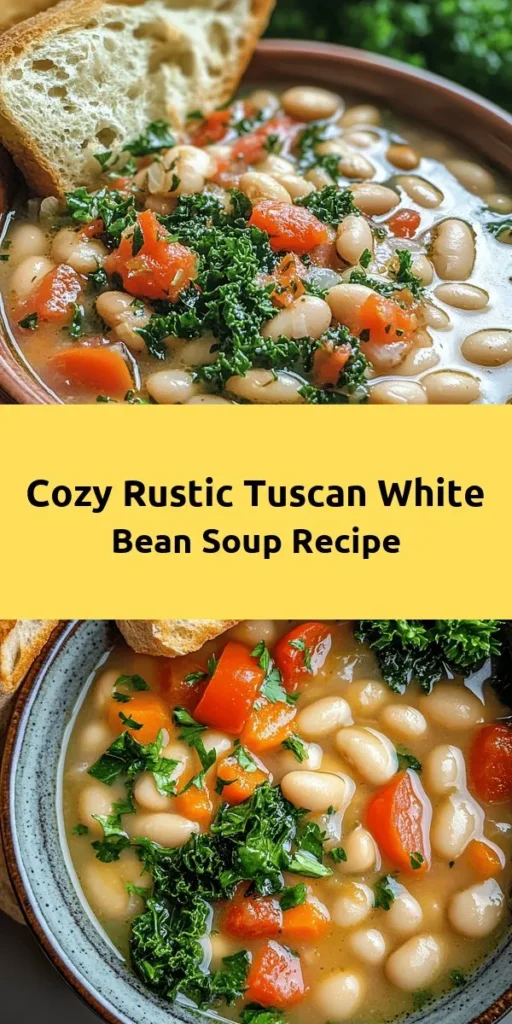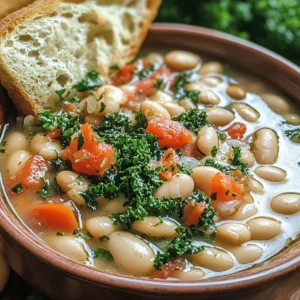Nestled in the heart of Italy, Tuscan cuisine embodies simplicity, warmth, and an appreciation for fresh, wholesome ingredients. Among its many delightful offerings, Rustic Tuscan White Bean Soup stands out as a comforting staple that has graced family tables for generations. This delightful soup is not only a celebration of flavors but also a testament to the region’s culinary philosophy—using the best seasonal produce to create hearty meals that nourish both body and soul.
What makes this soup so appealing is its ability to bring people together, whether it’s a cozy family dinner or a gathering with friends. With its nourishing ingredients and a rich blend of flavors, Rustic Tuscan White Bean Soup is perfect for those chilly evenings when all you need is a bowl of warmth. It is also a fantastic option for meal prep, allowing you to cook a large batch at once and savor it throughout the week.
In this article, we will explore the essential components that make this soup not only delicious but also a healthy plant-based choice. We’ll delve into the ingredients, their benefits, and provide a comprehensive guide to preparing this delightful dish. So, roll up your sleeves, and let’s get started on this culinary journey through Tuscany!
Understanding the Ingredients
White Beans
At the heart of any great bean soup are the beans themselves, and in this recipe, we spotlight white beans—specifically, either cannellini or great northern beans. These legumes are not only creamy and satisfying, but they also pack a nutritional punch.
White beans are an excellent source of plant-based protein, making them a perfect choice for those seeking to incorporate more meatless meals into their diet. They are rich in fiber, which aids digestion and helps maintain a healthy gut. Additionally, white beans provide essential vitamins and minerals, including iron, magnesium, and potassium, which contribute to overall health and well-being. Their mild flavor allows them to absorb the delicious broth and spices, making them a key ingredient in our Rustic Tuscan White Bean Soup.
Fresh Vegetables
When it comes to creating a flavorful base for our soup, fresh vegetables are indispensable. This recipe calls for a classic trio: onions, carrots, and celery—often referred to as the “holy trinity” of flavor in many cuisines.
– Onions provide sweetness and depth, caramelizing beautifully to form a rich foundation for the soup.
– Carrots add a natural sweetness and vibrant color, while also being packed with beta-carotene, which is converted to vitamin A in the body.
– Celery contributes a subtle crunch and unique flavor, along with antioxidants and vitamins that support heart health.
Together, these vegetables create a robust aromatic base that enhances the overall flavor profile of the soup.
Herbs and Spices
No Tuscan dish would be complete without the addition of herbs and spices. In our Rustic Tuscan White Bean Soup, rosemary and thyme take center stage, infusing the dish with their aromatic essence.
– Rosemary is a staple herb in Tuscan cooking, known for its pine-like fragrance and ability to elevate flavors. It also boasts anti-inflammatory properties and is rich in antioxidants, making it a healthy addition to any dish.
– Thyme complements rosemary beautifully, offering a subtle earthiness that enhances the soup’s depth. This herb has been linked to various health benefits, including improved respiratory health and antimicrobial properties.
The combination of these herbs not only enhances the soup’s taste but also provides a fragrant aroma that fills the kitchen as it cooks.
Broth and Tomatoes
To achieve a rich and hearty soup, the choice of broth and tomatoes is crucial. For this recipe, we recommend using vegetable broth as the base, which adds complexity and depth to the flavor profile without overpowering the other ingredients.
The addition of diced tomatoes brings acidity and brightness to the soup, balancing the creaminess of the white beans. Tomatoes are also an excellent source of vitamins C and K, as well as lycopene, an antioxidant known for its potential health benefits.
Together, the broth and tomatoes create a luscious, comforting liquid that envelops the beans and vegetables, making each spoonful a delight.
Leafy Greens
To add a burst of color and extra nutrients, we’ll incorporate leafy greens such as kale or spinach. These greens are packed with vitamins A, C, and K, as well as essential minerals like calcium and iron.
– Kale is particularly nutrient-dense, known for its antioxidant properties and ability to support heart health.
– Spinach is equally impressive, providing a wealth of nutrients while also contributing a tender texture to the soup.
Adding leafy greens not only enhances the nutritional profile of the soup but also provides a vibrant pop of color, making it visually appealing.
Optional Accompaniments
While the Rustic Tuscan White Bean Soup is delightful on its own, it can be even more satisfying when paired with crusty bread or homemade croutons. A slice of rustic Italian bread can be used to soak up the flavorful broth, while croutons add a delightful crunch, elevating the overall texture of the meal. These optional accompaniments make for a heartier meal, perfect for serving to family and friends.
Preparation Steps
Now that we’ve explored the key ingredients that make Rustic Tuscan White Bean Soup a nourishing and flavorful dish, it’s time to dive into the preparation process. Follow these detailed steps to ensure your soup turns out perfectly every time.
Sautéing the Base
The first step in creating a flavorful Rustic Tuscan White Bean Soup is to sauté the aromatic base. Begin by heating a few tablespoons of olive oil in a large pot over medium heat. Once the oil is shimmering, add the diced onions, carrots, and celery.
Sauté these vegetables for about 5-7 minutes, stirring frequently, until they become softened and the onions turn translucent. This step is crucial, as it releases the natural sugars in the vegetables, creating a sweet and aromatic base that will enhance the overall flavor of the soup.
Make sure to keep an eye on the heat—too high, and the vegetables may burn; too low, and they will take longer to cook. You want to achieve a nice balance, allowing the flavors to meld together beautifully.
Infusing Flavors
Once the aromatic base is ready, it’s time to elevate the flavor profile by adding minced garlic and the fresh herbs—rosemary and thyme. Add the minced garlic to the pot and sauté for an additional minute, until fragrant. Be cautious not to let the garlic brown, as it can become bitter if overcooked.
Next, stir in the chopped rosemary and thyme, allowing their essential oils to release into the mixture. This infusion of flavors is what makes Tuscan cuisine so unique and hearty. The combination of garlic and herbs will create an irresistible aroma that will have everyone eager to taste the soup.
Simmering the Soup
With the flavorful base prepared, it’s time to add the remaining ingredients to the pot. Pour in the vegetable broth and add the diced tomatoes, along with the drained and rinsed white beans. Stir everything together and bring the mixture to a gentle boil.
Once boiling, reduce the heat to low and let the soup simmer for about 20-30 minutes. This simmering process is vital, as it allows the flavors to meld and develop, resulting in a richly flavored soup. During this time, feel free to taste and adjust seasoning as necessary—adding salt, pepper, or even a splash of balsamic vinegar for a hint of tanginess.
About 10 minutes before serving, stir in the chopped kale or spinach, allowing it to wilt and blend into the soup. This final step not only adds a vibrant green color but also packs in extra nutrients, making the soup even healthier.
As the soup simmers and the ingredients meld together, you’ll notice the house filling with the tantalizing aroma of Tuscan cooking—a sure sign that your Rustic Tuscan White Bean Soup will soon be ready to enjoy.
With this detailed guide, you are now equipped to make a batch of Rustic Tuscan White Bean Soup that will warm your heart and satisfy your hunger. This dish is a perfect example of how simple ingredients can come together to create something truly special, representing the essence of Tuscan cuisine. Stay tuned for the next part, where we will explore tips for best results, common questions, and variations to enhance your cooking experience.




